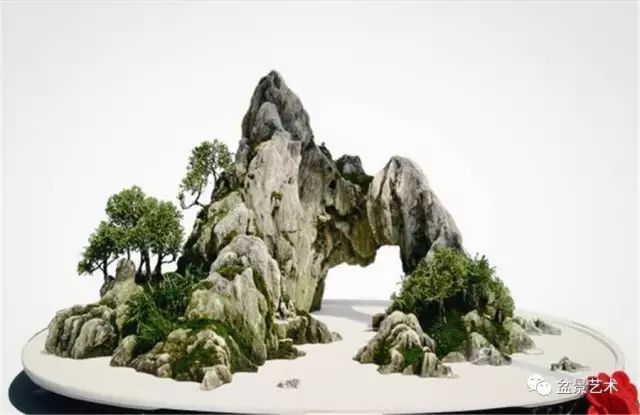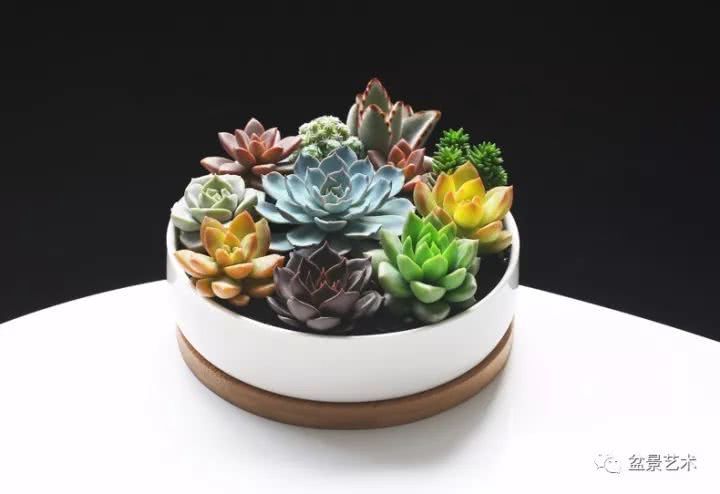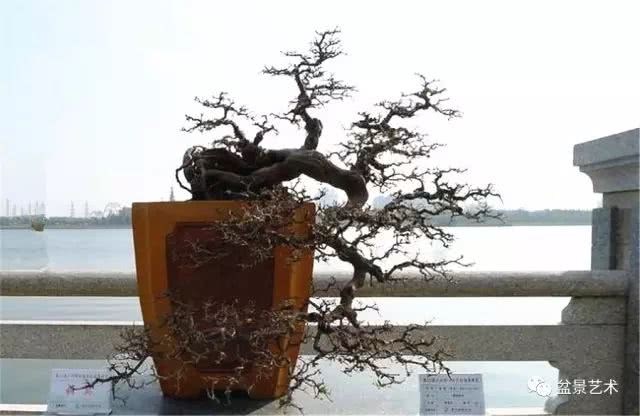A brief introduction to the steps of Landscape Bonsai

Landscape bonsai is a kind of bonsai mainly for ornamental rocks. To make landscape bonsai, we must first carry out artistic conception, determine the theme, and then take all or part of the stone materials suitable for shape according to the natural temperament of the rocks, and carve them artificially with plants and necessary accessories, and configure them into rockery. The natural scenery such as Qifeng, Gaoxia Feiyang, Baizhang Qianfeng, Cave and other natural scenery, condensed into a shallow basin, Sheng in several cases, like a three-dimensional landscape painting, such as before the blue waves and green water, between the famous mountains and rivers, full of interest.
1. Material selection and processing of mountains and rocks
First, mountain and stone material selection: landscape bonsai is a landscape formed by the arrangement and combination of mountains, stones, grass and trees in the bonsai. Mountain and stone materials are the main materials for the creation of landscape bonsai, and most of them are extracted from nature. Its texture, color and texturing patterns all have natural nature. When selecting materials, first of all, we should pay attention to determining that the stone is suitable for the shape of that kind of natural landscape according to the natural characteristics of the stone. if a group of sandy stones with vertical and simple textures, long shapes and natural contours are selected as materials for a basin of bonsai, it is affirmative that these materials are most suitable for the steep, towering and upright modeling landscape of Jianfeng, and we should pay attention to the texture, type and texturing pattern of the materials. It is best to use only one category of material, the color should not be too different.
Second, the tapping of the mountain outline: when we are making a basin of landscape bonsai for material selection, we should first observe the top outline of the stone, trigger the idea, and ponder over and over again, regardless of the hard stone or soft stone, when the outline line is not obvious, it should be tapped to make it undulating and full of rhythm.
Third, sawing and bonding: most of the time, a piece of stone can not form a complete picture of landscape bonsai, so it is necessary to combine multiple stones to form a landscape. The stone is generally natural and unprocessed, so the stone must be sawed, connected and bonded according to the landscape requirements, and the stone must be sawed with a cutting machine or hacksaw, or it can be broken by a hammer. Then use cement or cement to color, or other adhesives to form.
Fourth, the pattern and scattered: generally speaking, a basin of landscape bonsai requires roughly the same texture on the stone body, which shows that the landscape picture is more unified. However, because of the difference of the stone itself, under the premise of selecting the natural lines with the same texture as far as possible, it is sometimes necessary to adjust the texture of some stone materials whose textures are not obvious or have great differences in textures. the texture is generally done by ticking, digging, tapping and sawing, depending on the soft and hard properties of the stone. if some textures cannot be sorted out, the stone with roughly the same color can be used for splicing. The formation of a large block surface of the obvious concave and convex phenomenon, to meet the requirements of a unified and vivid landscape.
two。 The shape and style of landscape bonsai
Creative idea is an important part of bonsai creation. The creative idea of bonsai is actually a process of determining, conceiving and expressing the artistic conception. Generally speaking, there are two ways of expression:
First and according to this idea, select the appropriate trees, stones and mountains through the conception. Grass and other materials are arranged and combined in the pot space to complete this idea.
According to the specific characteristics of the shape of mountains, grass, trees, stones, give birth to a certain idea, and then conceive and use the shape characteristics of these mountains, stones, grass and trees, arrange and combine to complete the composition of a certain landscape and artistic conception. As the composition of bonsai landscape is limited by shaped materials, this conceptual conception method is widely used in bonsai modeling of rocks and various combinations.
Landscape bonsai generally has the theory of landscape modeling opening and closing, and mountains constitute complex landscape bonsai generally have a meeting or two opening and closing or three opening and closing methods. Opening and closing is a complete landscape composed of subject, guest, scattered stones and other complete mountains in the landscape bonsai. When the mountain is placed in the Bonsai, it can form a visual unit with spatial position in the bonsai. Due to the role of "tension" in the sense of composition (omni-directional two-way radiation), people's visual psychology creates a sense of expansion (that is, "potential"), which has the efficiency of occupying space. At the same time, because it has the orientation of the three-dimensional space (such as the orientation of the mountain in the pot scion), and occupies space asymmetrically, it forms a sense of motion in people's visual psychology and picture. The cause of motion is actually the imbalance caused by the radiation of the unfolding lines of visual units such as points or blocks in the picture, which is related to the position of the mountain surface in the "cloze space".
Contrast and contrast are also very important in the modeling of mountain and rock panoramic scenery, and the meaning of contrast and contrast is relatively broad. For example, the foil and contrast between big and small, subject and object, sparse and dense, Tibetan and exposed, virtual and real, front and back, stone and tree, all these must be embodied according to the creative theme and techniques. Only by mastering the rules of creation, can we be of one mind.
3. Application of scattered Stone in Landscape
The position of the subject and object of the landscape bonsai is very important in the bonsai, and their charm, volume and situation are directly related to the artistic conception of the works. However, whether their function is outstanding or not is related to the use of scattered stone, which is usually neglected.
Scattered stone is a kind of scattered and unique foil placed in the blank space of landscape bonsai in the form of groups. it itself has the nature of "point" in the sense, and it is a kind of visual unit with spatial position. When people's line of sight is focused on it, it produces a sense of expansion in people's visual psychology, so it can occupy and divide the space.
The function of scattered stone is mainly shown in the following aspects:
(scattered stones serve as a foil to the main mountain)
As the foil of the main and guest mountains in the bonsai, the bonsai is characterized by seeing the big in the small, but no matter how big the bonsai is, the volume of the main and guest peaks is limited. In order to make people feel psychologically that "one peak is too flamboyant and spirited", we must use some low and small foil to highlight the main peak and guest bees, so as to make it look much larger than the actual existence and increase its sense of volume. Scattered stones play an excellent foil role in this respect.
(division of scattered stones in blank space)
As a division of the blank space on the water surface of the foot of the mountain: bonsai is a three-dimensional shape, it is impossible to float the mountain in mid-air like landscape painting, and the following is omitted by clouds or something else. The mountain stone in the basin must take root. When we set the rocks of the subject and object in the urn, the remaining blank space needs to be dealt with carefully. Bonsai jargon says, "the peak is easy to stand, but the foot is difficult to deal with" refers to this process. The manipulation of scattered stones is the treatment and division of the blank space on the water surface of the mountain foot. As mentioned earlier, scattered stones should have a sense of expansion and tension in people's visual psychology, so that they can play the role of occupying space in the blank space, so if the scattered stones are arranged properly, the water surface of the mountain foot can be divided reasonably. Rich in variety.
(scattered stones act as nodes in an opening and closing pattern)
In landscape bonsai, especially in bonsai with an opening and closing pattern, it plays the role of "knot": we know that in bonsai, especially in bonsai where both the subject and the guest exist at the same time, and in the bonsai with an opening and closing pattern, their direction arrangement generally contains four links: "rise, inherit, turn, knot". The so-called "layers of potential" refers to the organic combination of these four links, and "knot" is the completion point of these four links. The scattered stone is precisely such a "node", which ends in a vivid picture and plays a final role in the development of the mountain situation.
4. Planting of plants and embellishment of accessories
After the completion of the mountain and stone combination modeling of the landscape bonsai, plants should be planted and accessories embellished. The painting theory says: "the body of the mountain, the stone is the bone, the tree is the clothing, and the pavilion bridge is the embellishment." Stone is an inanimate solid, while a tree is the symbol of its landscape life. As the jargon says, "the stone is easy to stand, but it is difficult to plant plants." this shows the importance of plants in mountain and stone bonsai. Experts all have such a feeling that after the formation of the rocks, the bonsai landscape is actually only half finished, and it can only be counted as complete after the plant has been planted. Often, the energy and time spent on plant planting exceeds the time spent on the combination of stone materials.
It is better to plant plants with short leaves and twigs, with different plants in different landscapes. Such as solitary peak landscape, you can choose old and sturdy plants; groups of peaks stand on the wall, you can choose the combination of luxuriant jungle planting; gentle hillsides, embellished with dwarf plants. At the same time, we can use the methods of setting off, embellishing, interspersing, flying, overlapping and close planting, but we should pay attention to the law of "Zhangshan ruler tree" in the proportion of general planting law. generally speaking, it is better to plant according to the composition principle of "rising, inheriting, turning, knot and closing".
Accessories are the starting point or foil in the landscape bonsai, but it should be noted that the creation of landscape bonsai should not be based on embellishment accessories, but should be based on landscape modeling. Accessories can not be stacked, misplaced, to be hidden, dense and appropriate, to pay attention to the "near big, far small" rule and perspective relationship.
- Prev

Maintenance and management of succulent plants
First, the cultivated soil requires that the soil is loose, permeable and well drained, but it has a certain water retention capacity and is neutral or slightly acidic. Highland globules (Yuejie, Yuehua, Amber) and Peony can add a little more rice chaff ash and small.
- Next

Excellent style and amorous feelings
Bihai Jiaolong Phoenix downhill leisurely crane dance do you like this article? Share it now and let more people know! The content of this site.
Related
- Wuhan Hospital Iron Tree Blooming Result Was Instantly Frightened by the Gardener Master
- Which variety of camellia is the most fragrant and best? Which one do you like best?
- What is the small blue coat, the breeding methods and matters needing attention of the succulent plant
- Dormancy time and maintenance management of succulent plants during dormancy
- Minas succulent how to raise, Minas succulent plant pictures
- What are the varieties of winter succulent plants
- How to raise succulent plants in twelve rolls? let's take a look at some experience of breeding twelve rolls.
- Attention should be paid to water control for succulent plants during dormant period (winter and summer)
- Watering experience of twelve rolls of succulent plants
- Techniques for fertilizing succulent plants. An article will let you know how to fertilize succulent plants.

